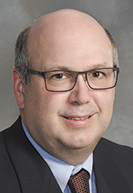Subscriber Benefit
As a subscriber you can listen to articles at work, in the car, or while you work out. Subscribe NowAs a young television reporter, Brandi Davis-Handy once dreamed of becoming the next Oprah Winfrey, with a media empire that would allow her to share stories with millions of people.
Instead, she now runs the day to-day operations of AES Indiana, the Indianapolis-based utility that serves electricity to about a half million people in central Indiana. But she sees comparisons.
Davis-Handy, 45, was named president of the utility last month, with the goal of leading the transition from coal to cleaner energy while building connections and relationships in the community. In many ways, she is the public face of AES Indiana.
“I think that’s what made me want to be the next Oprah—and wanting to hear the stories and tell the stories translates well,” she said, “because I think that there’s probably no better story to tell right now than the energy transition that’s happening not just across the U.S., but right here in Indiana.”

Yet she takes over at a challenging time. Last summer, AES Indiana came under sharp criticism after a line of thunderstorms left some customers without power for nearly a week, raising questions about the company’s ability to respond quickly to restore energy.
Over a 9-month period in 2022- 2023, customer advocates say AES Indiana disconnected more households that fell behind in monthly payments than have any of its peer utilities.
And a recent billing-system upgrade designed to improve the customer experience caused some customers’ monthly bills to skyrocket, with double and triple the normal charges—increases those customers did not have to pay. AES Indiana said the problem affects about 10% of its customers. It apologized and said it is repairing the glitch.
The utility is also gaining the reputation of having a revolving door in its executive suite after going through six other presidents in the past decade, two of whom lasted less than 12 months.
Many also carried the CEO title, but those roles are now split. Ken Zagzebski, who was named president and CEO last August, will remain CEO as well as senior vice president of parent AES Corp., based in Arlington, Virginia.
Zagzebski succeeded Kristina Lund, who stepped down last summer after nearly three years in the top job to become president of Pattern Energy Group, a renewable-energy power company based in San Francisco.
Some customer groups and consumer advocates said they hope Davis-Handy can get on top of the problems and restore public confidence.
“AES has a lot of work to do in regaining the trust of their customers and the city that they serve,” Kerwin Olson, executive director of Citizens Action Coalition of Indiana, told IBJ.
But he added that Davis-Handy, who was raised in Indiana and spent most of her career here, could meet the challenge. “Someone with her background should prove a valuable asset in working to build back public confidence,” he said.
Greg Ellis, vice president of energy and environmental policy at the Indiana Chamber, sounded optimistic about Davis-Handy’s leadership style.
“All of my interactions with Brandi have been very positive,” he said. “She is very collaborative and should do a great job leading AES in her new role.”
Davis-Handy is widely known as an exuberant and sociable personality who remembers names, faces and details about other people and organizations. She serves on the boards of numerous civic and not-for-profit organizations, including Big Brothers and Big Sisters of Indiana, the Indy Chamber, Indiana Sports Corp. and the 500 Festival.
She also sits on the board of the Urban League of Indianapolis, perhaps a key fit as a utility president and Black executive.
She will doubtless need to call on many of those groups and people to help the utility regain its footing.
“Brandi is an incredible person and an incredible talent,” said Zagzebski, her boss as the utility’s CEO. “She knows everybody. … You know the old saying: ‘It’s not who you know, but who knows you.’ She has tremendous respect in the community.”
Shifting energy sources
All of Davis-Handy’s talents will need to come into play as AES Indiana—like many utilities—shifts further from coal to other energy sources, such as natural gas, wind and solar.
In the past decade or so, AES has stopped using coal at two of its three power stations (Harding Street on the south side of Indianapolis and Eagle Valley in Martinsville) and converted those plants into natural gas as a fuel source.
It has also converted two of the four generating units at its largest power station, Petersburg in Pike County, to natural gas. Earlier this month, the utility announced it had filed a request with regulators to convert the remaining two coal-generating units at Petersburg to natural gas.
It said the conversion would save customers about $280 million over a 20-year period and would reduce carbon intensity 70% from 2018 levels by 2030. The Petersburg plant is about 120 miles southwest of Indianapolis.
If state regulators agree, AES Indiana would be the first of the five investorowned electric utilities in the state to cease burning coal, the company said. Since 2012, electric utilities across Indiana have retired or converted 29 coal-fired units, with another 20 in the works by 2035, state regulators said in their 2023 annual report.
“This is the best option for our customers,” Davis-Handy said of the Petersburg move. “It not only creates the decarbonization that we need, but from an affordability standpoint … helps the wallets of our customers. That’s very, very important.”
Monthly bills are a key barometer for any utility. As of last July 1, AES Indiana had the lowest residential electric bills of any investor-owned utility in the state.
But the utility is not holding a lid on rates. Last fall, it reached a settlement agreement with customer groups that would raise monthly rates about 7.3% for the average residential customer.
AES Indiana leaders called the agreement a “a critical step” to make certain it could afford investments in its huge system and ensure reliability.
The deal, still awaiting approval by the Indiana Utility Regulatory Commission, would raise monthly rates by $9.52, or approximately 7.3%, for the average residential customer using 1,000 kilowatt hours a month. That’s less than its initial proposal, which would have raised rates about $17 a month, or 13%.
In exchange, customer advocacy groups got AES Indiana to agree to clamp down on its aggressive disconnection practice and offer other consumer protections. The utility’s initial proposal provoked widespread objections, including from more than 40 customers who attended two field hearings.
The operation Davis-Handy is inheriting seems to be stable in the eyes of investors. This month, Fitch Ratings gave AES Indiana’s corporate holding company, IPALCO Enterprises Inc., its fourth-highest rating, BBB, on $400 million senior secured notes, with a “stable” outlook.
“IPALCO’s ratings continue to be driven by the stable and predictable regulated utility operations in Indiana,” analyst Ivana Ergovic wrote to clients on March 8.
Large portfolio
Davis-Handy’s role as president seems to include a larger portfolio than that of some of her predecessors. She will oversee a raft of functions, including government and regulatory affairs, customer experience, communications, business growth and economic development, strategic accounts, energy efficiency, and community impact.
She will also oversee a $500 million operations and maintenance budget and a capital expenditure budget of $1.2 billion.
She won’t oversee energy transmission or distribution, two key functions of an electric utility. But she said she will work closely with those who do. “I’m working in partnership with that team to ensure the prioritization of the investments that need to be made right now,” she said.
AES Indiana said splitting top Indiana management into separate CEO and president roles is meant to improve responsiveness to each market. Unlike several predecessors, Davis-Handy will oversee only the Indiana operations, not a sister operation in Dayton as well.
“The Indiana and Ohio presidents each have deep community connections, understand residential and commercial client needs and have visions for how to continue evolving a Midwest-based utility in a constantly changing environment,” the utility told IBJ in an email.
Davis-Handy will also guide the utility into more renewable energy. AES Indiana said in 2022 it wants to add up to 1,300 megawatts of wind, solar and storage by 2027.
Earlier this month, the utility announced it had acquired a large wind farm in northwestern Indiana, with 53 wind turbines that could produce enough power for 29,000 homes. The wind farm, known as The Hoosier Wind Project, has been supplying power to AES Indiana since 2009 under a 20-year power purchase agreement. Purchase terms weren’t disclosed.
The utility said the farm’s windmills reduce CO2 emissions by 286,700 tons per year compared with other generation options.
“Hoosier Wind is an important contributor toward our portfolio evolution and our promise to deliver 100% clean energy to our customers by 2050,” Davis-Handy said in the announcement.
If she wants to get public buy-in for the utility’s strategies, Davis-Handy will need to tap into her deep background in communications. After graduating from Lawrence Central High School, she earned a degree in mass media arts at Hampton University in Virginia.
She returned to Indianapolis in 2005 after working as a TV journalist in North Carolina. She worked through a series of community jobs, including communications roles at the 500 Festival, the American Cancer Society’s Great Lakes Division and AES Corp. (then known as Indianapolis Power & Light Co.)
She rose through the ranks at the utility to communications leader for U.S. utilities before leaving for about 2-1/2 years to take executive roles at Indianapolis financial firm OneAmerica and Project Lead the Way, a not-for-profit that developsscience and math curriculums for schools.
She returned to the utility in 2021 as chief public relations officer for U.S. utilities and quickly rose to chief customer officer in 2022 and president last month.
“I came back because I missed the people. I missed the industry,” she said. “When I left, I found myself still looking at trade publications like Utility Dive. I realized, ‘Brandi, you miss the utility industry.”•
Please enable JavaScript to view this content.



Just another diversity hire. What a joke.
A couple of years ago, representatives of this monopoly, during an overnight power outage, trimmed the fence row behind my home and left an awful mess of debris in my yard that, after much grousing, was my responsibility to clean up. I wish I had an alternative provider.